ice
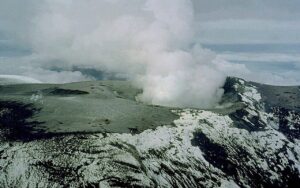 A full year before Nevado del Ruiz, the highest active volcano in the Andes Mountains of Colombia, erupted on November 13, 1985, the mountain began to show warning signs. The people living in the surrounding area, especially the town of Armero, were warned of a pending eruption, but a year is a long time to wait for a predicted eruption to occur, and after a while, the people began to consider the warnings to be false alarms. After a time, life went back to “business as usual” as the people believed the warnings were like a predicted blizzard that never materializes.
A full year before Nevado del Ruiz, the highest active volcano in the Andes Mountains of Colombia, erupted on November 13, 1985, the mountain began to show warning signs. The people living in the surrounding area, especially the town of Armero, were warned of a pending eruption, but a year is a long time to wait for a predicted eruption to occur, and after a while, the people began to consider the warnings to be false alarms. After a time, life went back to “business as usual” as the people believed the warnings were like a predicted blizzard that never materializes.
When the predicted eruption began on November 13, 1985, the people though they had been right, and the area had dodged a bullet, because the eruption was actually considered a mild one. The eruption produced a series of lava flows that surged over the volcano’s broad ice-covered summit. the super-heated lave became flowing mixtures of water, ice, pumice, and 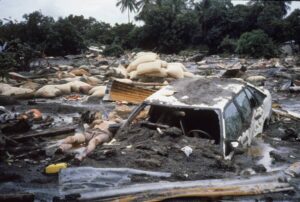 other rock debris that poured off the summit and sides of the volcano, forming “lahars” that flooded into the river valleys surrounding Ruiz. A lahar is a destructive mudflow on the slopes of a volcano. The lahars joined normal river channels, filling them to flood levels. To make matters worse the situation was exacerbated by heavy rain. Within four hours of the eruption, the lahars had traveled over 60 miles, killing more than 23,000 people, injuring over 5,000, and destroying more than 5,000 homes. The town of Armero was the hardest hit, losing three quarters of its 28,700 inhabitants. The lahars destroyed everything in their paths: roads, bridges, farm fields, aqueducts and telephone lines. They wiped out 50 schools, two hospitals, in addition to the more than 5,000 homes. The region lost 60 percent of its livestock, 30 percent of grain and rice crops, and half a million bags of coffee. 7,500 people were left homeless.
other rock debris that poured off the summit and sides of the volcano, forming “lahars” that flooded into the river valleys surrounding Ruiz. A lahar is a destructive mudflow on the slopes of a volcano. The lahars joined normal river channels, filling them to flood levels. To make matters worse the situation was exacerbated by heavy rain. Within four hours of the eruption, the lahars had traveled over 60 miles, killing more than 23,000 people, injuring over 5,000, and destroying more than 5,000 homes. The town of Armero was the hardest hit, losing three quarters of its 28,700 inhabitants. The lahars destroyed everything in their paths: roads, bridges, farm fields, aqueducts and telephone lines. They wiped out 50 schools, two hospitals, in addition to the more than 5,000 homes. The region lost 60 percent of its livestock, 30 percent of grain and rice crops, and half a million bags of coffee. 7,500 people were left homeless.
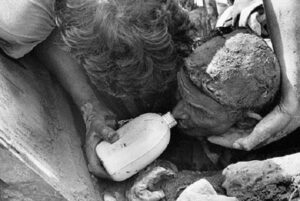
Because there had been ample warning, the losses could have been minimal, if the people living in the river valley had moved to higher ground. It’s not completely their fault. We humans, have a tendency to lose faith in what we have been told, when thing don’t happen immediately. After a year of hearing that the volcano was going to erupt, people began to think that the vulcanologists were wrong. Then, when it did start, it didn’t seem to be the horrendous eruption that had been predicted. All this led to a lack of a feeling of urgency, and thereby, they death of 23,000 people. So very sad that we could so carelessly refuse to take heed.
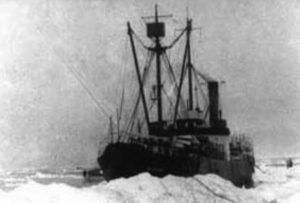 Ghost ships have been a prominent tale of mystery over the years. Many say that seeing a ghost ship is an omen of doom, which I do not believe in, nor do I believe in ghosts or ghost ships, but there was a ship that was dubbed a ghost ship, and has had the longest standing as a possible ghost ship in history, at least to my knowledge. The SS Baychimo was a cargo ship that was built in 1914 in Sweden. It was used for trading routes between Hamburg and Sweden. After World War I, the ship was sold to the Hudson’s Bay Company. The ship made numerous sailings for Hudson’s, mostly carrying cargo to and from the Arctic region.
Ghost ships have been a prominent tale of mystery over the years. Many say that seeing a ghost ship is an omen of doom, which I do not believe in, nor do I believe in ghosts or ghost ships, but there was a ship that was dubbed a ghost ship, and has had the longest standing as a possible ghost ship in history, at least to my knowledge. The SS Baychimo was a cargo ship that was built in 1914 in Sweden. It was used for trading routes between Hamburg and Sweden. After World War I, the ship was sold to the Hudson’s Bay Company. The ship made numerous sailings for Hudson’s, mostly carrying cargo to and from the Arctic region.
The Baychimo had a lucrative career until October 1, 1931, when it was on a routine voyage, filled with recently acquired furs. An unexpected storm blew in, trapping the ship in a sea filled with ice. The closest city was Barrow, Alaska, the northern most city in the United States, and almost like being on top of the world, but it was too far to get to in the blowing snow and high winds. The captain and crew had to stay inside the trapped ship, where they hoped to wait out the storm. This storm was the beginning of the more bizarre part of Baychimo’s life.
When October 15th rolled around, the ship could still be found stuck in the ice, so 15 of the crew members were airlifted to safety. The captain and 14 other crew members made a temporary camp on the ice near the stranded ship…which turned out to be a very wise decision. The terrible weather continued to pound the crew and the “temporary” camp became home for weeks. Then, on November 24th, a fierce blizzard hit the area, and the snow was so heavy that the campers could no longer see the Baychimo, which was still trapped in the ice…or so they thought. The next morning, it was just as the expected. The ship had vanished. They assumed that it had been sunk by the preceding blizzard. The remaining crew made their way back to civilization.
Then, less than a week later, a hunter told the captain that the Baychimo could not have sunk, as he had just seen it floating in the icy waters almost fifty miles from the location where it had been abandoned. The captain was, understandably reluctant to battle the snows to try and find the ship, knowing that it could be miles for the last known location. Nevertheless, he gathered his crew and went looking. Just as the hunter had said, they found the Baychimo in the location the hunter had described. The ship looked like it was no longer seaworthy, so the captain didn’t think it would stay afloat much longer and would soon break apart and sink, so the crew gathered the cargo of furs and had everything, including the captain and the crew, airlifted out of the area.
The captain was wrong. The SS Baychimo was spotted again and again. In March of 1933, some Eskimos, trapped by a storm, took shelter in the Baychimo for a week until the weather improved enough to journey back to their homes. In November of 1939, another ship came close enough to the Baychimo that they were 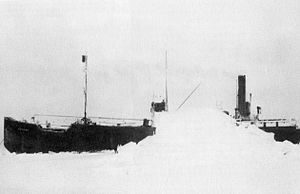 able to board the abandoned ship, but due to the approaching ice floes, the captain did not have the time to bring it back to a port, although he did report the empty ship’s location. In 1969, the Baychimo was spotted at a distance, once again trapped in an ice pack. This was the last recorded sighting of the ship, and after a few years it was commonly believed that the ship did eventually give in to its deteriorating condition and sank to the bottom of the frigid seas. Not everyone agreed though, because in 2006, seventy-five years after the ship was first abandoned, the state of Alaska formally began an effort to find the mysterious SS Baychimo, the Arctic’s elusive wandering ship.
able to board the abandoned ship, but due to the approaching ice floes, the captain did not have the time to bring it back to a port, although he did report the empty ship’s location. In 1969, the Baychimo was spotted at a distance, once again trapped in an ice pack. This was the last recorded sighting of the ship, and after a few years it was commonly believed that the ship did eventually give in to its deteriorating condition and sank to the bottom of the frigid seas. Not everyone agreed though, because in 2006, seventy-five years after the ship was first abandoned, the state of Alaska formally began an effort to find the mysterious SS Baychimo, the Arctic’s elusive wandering ship.
 Years ago, long before refrigeration was safe to use, most people had a more primitive way to keep foods fresh or frozen. I say that this was before refrigeration was safe to use, because mechanical refrigeration was actually invented in 1748 by William Cullen and was demonstrated at the University of Glasgow. This version was not used for any practical purpose, however. In 1805, an American inventor named Oliver Evans designed the first refrigeration machine, and the first person to make a practical refrigerating machine was Jacob Perkins in 1834, using Ether in a vapor compression cycle. American physician, John Gorrie, built a refrigerator based on Oliver Evans’ design in 1844 which he used to make ice to cool the air for his yellow fever patients. German engineer Carl von Linden, patented not a refrigerator but the process of liquefying gas in 1876 that is part of basic refrigeration technology. Refrigerators in the late 1800s and up until 1929 used toxic gasses, such as ammonia, methyl chloride, and sulfur dioxide as refrigerants, which were responsible for several fatal accidents in the 1920s. I suppose the cost and the dangers of these early models were the main reasons that people continued to used the old fashioned version.
Years ago, long before refrigeration was safe to use, most people had a more primitive way to keep foods fresh or frozen. I say that this was before refrigeration was safe to use, because mechanical refrigeration was actually invented in 1748 by William Cullen and was demonstrated at the University of Glasgow. This version was not used for any practical purpose, however. In 1805, an American inventor named Oliver Evans designed the first refrigeration machine, and the first person to make a practical refrigerating machine was Jacob Perkins in 1834, using Ether in a vapor compression cycle. American physician, John Gorrie, built a refrigerator based on Oliver Evans’ design in 1844 which he used to make ice to cool the air for his yellow fever patients. German engineer Carl von Linden, patented not a refrigerator but the process of liquefying gas in 1876 that is part of basic refrigeration technology. Refrigerators in the late 1800s and up until 1929 used toxic gasses, such as ammonia, methyl chloride, and sulfur dioxide as refrigerants, which were responsible for several fatal accidents in the 1920s. I suppose the cost and the dangers of these early models were the main reasons that people continued to used the old fashioned version.
The old fashioned way to keep foods fresh or frozen, involved using ice and snow, which they would bring in from the mountains, or use what was on the ground, if it was available. They would dig a cellar in the ground, 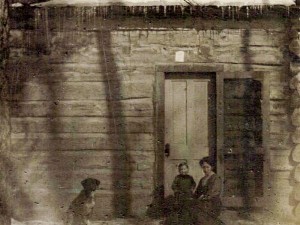 and line it with wood or straw. Then they packed it with snow and ice, and the food was placed in the cellar. It was this type of refrigeration system that my grandparents, Allen and Anna Spencer, were using at the time my Aunt Laura Fredrick was a very little girl in about 1913. My grandparents were living in a wooded area in northern Minnesota near American Falls. Grandpa was working in the lumber business at that time.
and line it with wood or straw. Then they packed it with snow and ice, and the food was placed in the cellar. It was this type of refrigeration system that my grandparents, Allen and Anna Spencer, were using at the time my Aunt Laura Fredrick was a very little girl in about 1913. My grandparents were living in a wooded area in northern Minnesota near American Falls. Grandpa was working in the lumber business at that time.
According to my Uncle Bill Spencer, who was their second child, the cellar was probably not needed much in the long winter months, because the house stayed pretty cold up there anyway. I’m sure that they had wood for a fire, but then again, I suppose that everything they burned, was something that could not bring in money. Also, they lived in a log cabin, that was apparently not very well built, or at least the spaces in between the logs were not really well packed with mud to keep the cold winter air on the outside of the house, where it belonged.
I’m not sure how far the cellar was from the house, because, I can’t see the house in the picture, so it might have been a little way from the house, or the picture might have been taken from the house. Either way, getting food from the cellar was a bit of a process, because you don’t want to upset the cooling process by removing the straw too often, as it was part of what kept the ice and snow from melting.
 I can’t say when my grandparents got their first real refrigerator, but I expect that like many people of that time, they were a little bit leery of the early refrigerators, after hearing about people dying because the gasses leaked out of the unit. I suppose it was the price people paid to be able to use some of the early inventions, but many people felt that the price was too high, so they waited until these new fangled gadgets were proven safe before they took a chance on them. And, I’m sure that like any new thing, they were pretty expensive early on too. The cellar would work just fine for now, and therefore, that is what my grandparents were using at that time in our family history. These days, we would be shocked at such a method of keeping food fresh.
I can’t say when my grandparents got their first real refrigerator, but I expect that like many people of that time, they were a little bit leery of the early refrigerators, after hearing about people dying because the gasses leaked out of the unit. I suppose it was the price people paid to be able to use some of the early inventions, but many people felt that the price was too high, so they waited until these new fangled gadgets were proven safe before they took a chance on them. And, I’m sure that like any new thing, they were pretty expensive early on too. The cellar would work just fine for now, and therefore, that is what my grandparents were using at that time in our family history. These days, we would be shocked at such a method of keeping food fresh.
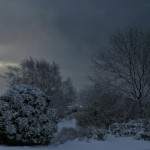 I am not a Winter person, which is odd since I live in Wyoming, because we definitely get Winter. Still, there are times when I feel differently about it. Normally, the cold and, in Wyoming, the wind annoy me, as does the ice on the roads, but every once in a while, there is a night…or even just a few minutes that I feel…peaceful in the snow.
I am not a Winter person, which is odd since I live in Wyoming, because we definitely get Winter. Still, there are times when I feel differently about it. Normally, the cold and, in Wyoming, the wind annoy me, as does the ice on the roads, but every once in a while, there is a night…or even just a few minutes that I feel…peaceful in the snow.
Life these days is so hectic, and there is seldom a moment to slow down, much less look around for beauty in the night air, so when there is a rare moment of peace and quiet, you want to savor it for as long as you can, before the rest of your hectic life catches up with the present time and you must return to normalcy…or maybe it is chaos.
I’m talking about that moment when you step outside, and it is so very quiet. Even though I live in a city, and quiet moments are rare, it was a moment with no cars going by. It took me by surprise. I just stepped outside, and stopped…because it was so very quiet. Everything was so very still that it felt like…a whisper. It’s hard for me to clearly describe that moment. It was so peaceful…so beautiful. It was the kind of moment when it felt, almost criminal to speak, because that kind of silence should not be broken. It was a gift, a precious moment of quiet, peaceful beauty…and it seemed to be here just for me, because no one else was around to notice or to care.
The sky was white and cold looking and the trees were perfectly still. The air was so still that it almost felt like it was frozen solid, and hanging there…suspended above the Earth. The night was so beautiful that it took my breath away. The moon peeked through the clouds and cast a soft light on the Earth below it. Along the street there were Christmas light twinkling, bringing the reminder of the wonderful season we are in. But, the amazing thing was that no one disturbed the silence, because no one was outside in the area but me.
In my hectic life, this particular moment felt totally foreign to me, and I couldn’t help but smile, because the whole scene was like stepping into a Christmas card. Perfect in every way. All too often we rush here and there trying to get all of our obligations done, and because there are so many other people out there doing the same thing, we all miss God’s beauty, that was given to us. While there is not much that can be done to slow our hectic lives, I feel very blessed to have been given just a moment that made me stop in awe and wonder at the peaceful scene around me.

